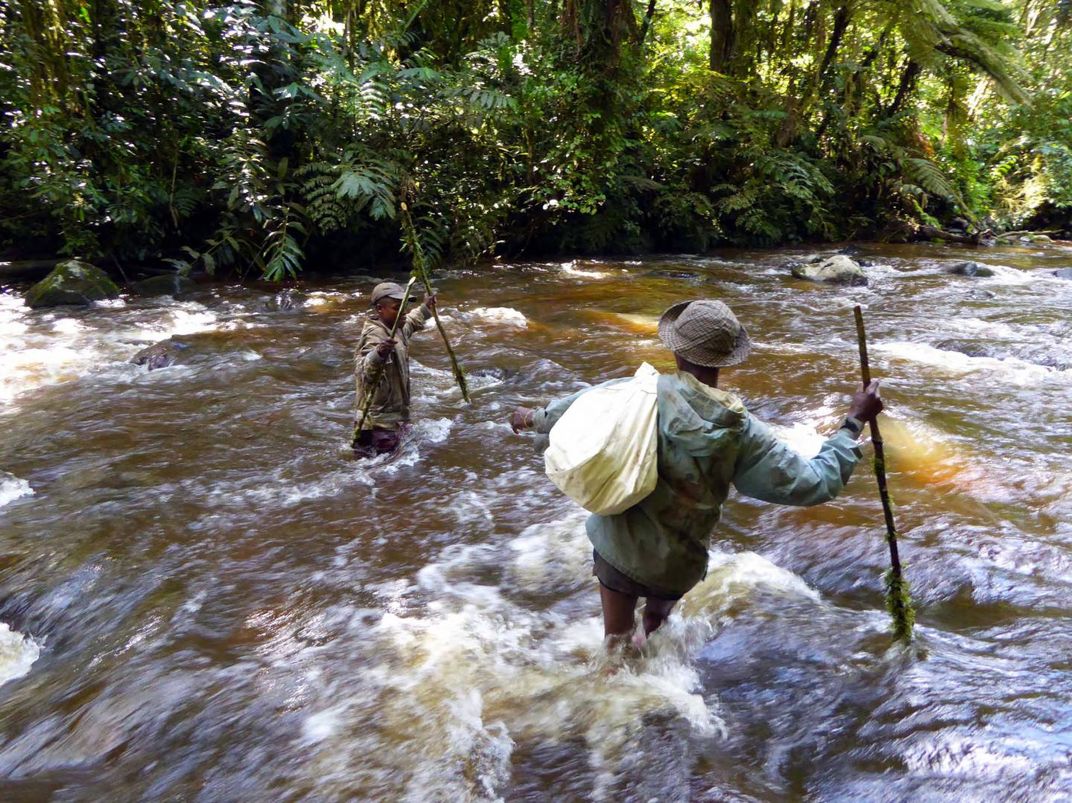Two New Species of Semi-Aquatic Mice Identified in East African Rainforests
Mice from the genus Colomys stand on kangaroo-like feet to wade in shallow water and use their whiskers to find prey
/https://tf-cmsv2-smithsonianmag-media.s3.amazonaws.com/filer/93/2a/932aa586-ef94-47dd-b1ec-c6704f607577/2020_oct14_watermouse.jpg)
African wading mice are not just larger than your average house mouse—they’re also more adventurous. Also called Colomys mice, the rodents stand on their long, stilt-like feet to wade in the shallows of swamps and rivers, skating their long whiskers on the surface of the water to sense the movement of prey, like insects and tadpoles, George Dvorsky reports for Gizmodo.
When Colomys mice were found prowling riverbeds across east Africa, scientists first classified them all as one species, C. goslingi, with one subspecies. But new research published in the Zoological Journal of the Linnean Society brings together careful measurements and genetic data to show that there are actually four species of Colomys mice.
“[C. goslingi] was known all the way from Liberia to Kenya, which is an insanely wide distribution for a really small animal,” says Siena College biologist Tom Giarla to New Scientist’s Jake Buehler. Giarla and his colleagues suspected that the tropical forests hid a range of related mice species, and that’s what they found.
Two of the four species described in the paper were previously known to science, C. goslingi and the subspecies, which the paper argues is a standalone species, C. einsentrauti. The other two species are new. The researchers named the species C. wologizi, for Liberia’s Wologizi mountains, and C. lumumbai, for Patrice Lumumba, a leader for Congolese independence and the Democratic Republic of the Congo’s first prime minister.
The mice share features like a thick, waterproof coat with a bright white belly; long, kangaroo-like feet; and big brains.
“Their skull volumes are huge relative to other African rodents. We think this is to support the mechanosensory system associated with their long whiskers, which they use to hunt aquatic animals like insect larvae and tadpoles,” Giarla tells Gizmodo in an email. “…They are oddballs.”
The research team came from universities across North America, Europe and Africa, the researchers note in a statement. They had to tackle dense rainforest to reach the mice’s habitats on the shores of remote rivers, at times making three- to four-day treks or wading through waist-deep water. After heavy rainstorms, the collection traps that had been placed on a river’s shore could be washed downstream.

The team faced “medical evacuation due to depleted oxygen” caused by histoplasmosis, an infection caused by fungal spores found in bird and bat droppings, and “local militias kidnapping and killing Congolese colleagues,” Julian Kerbis Peterhans, adjunct curator of the Field Museum’s Negaunee Integrative Research Center, tells ZME Science in an email.
Peterhans adds to ZME Science that he recalls “delight in working with host-country colleagues, a hot cup of coffee at 7 a.m. after checking traplines, crossing the Semliki River with a single outboard motor strapped to the canoes and wooden planks supporting two vehicles, the first time terror of hearing the screeching tree hyrax at nightfall.”
The researchers collected several specimens of stilt-footed mice, sequenced their DNA and took careful measurements. One of the new species, C. lumumbai, appeared nearly identical to the first recognized species, C. goslingi, but their DNA and skull measurements showed the two are distinct, Peterhans tells ZME Science.
The researchers also looked at another specimen of semi-aquatic mouse, from the species Nilopegamys plumbeus, which was collected 93 years ago in Ethiopia and brought back to the Field Museum in Chicago. By comparing its DNA to the Colomys mice, the researchers showed that the two types of mice are closely related. But because another specimen hasn’t been found in nearly a century, the researchers suspect that the Ethiopian river mouse is extinct by now. It’s a warning sign for small mammals like the newly described Colomys mice.
“Species cannot be adequately conserved and protected unless they are described,” says Australian National University evolutionary biologist Emily Roycroft, who wasn’t involved in the study, to New Scientist. “I’m hopeful that this study and future studies will aid the conservation of African biodiversity into the future.”
Wildlife in East Africa face a myriad of threats from climate change and habitat destruction, Peterhans tells ZME Science, and the new study was motivated by the fact that small mammals like mice are often overlooked. Expeditions in 2020 have been delayed because of the Covid-19 pandemic, shortening the amount of time when conservation scientists could conduct research in the field.
Giarla tells Gizmodo, “Some species with small ranges will likely go extinct soon if more of the forest isn’t protected.”